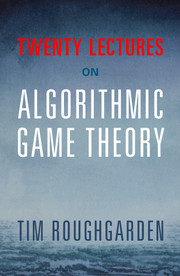Book contents
- Frontmatter
- Dedication
- Contents
- Preface
- 1 Introduction and Examples
- 2 Mechanism Design Basics
- 3 Myerson's Lemma
- 4 Algorithmic Mechanism Design
- 5 Revenue-Maximizing Auctions
- 6 Simple Near-Optimal Auctions
- 7 Multi-Parameter Mechanism Design
- 8 Spectrum Auctions 97
- 9 Mechanism Design with Payment Constraints 113
- 10 Kidney Exchange and Stable Matching
- 11 Selfish Routing and the Price of Anarchy
- 12 Over-Provisioning and Atomic Selfish Routing
- 13 Equilibria: Definitions, Examples, and Existence
- 14 Robust Price-of-Anarchy Bounds in Smooth Games
- 15 Best-Case and Strong Nash Equilibria
- 16 Best-Response Dynamics
- 17 No-Regret Dynamics
- 18 Swap Regret and the Minimax Theorem
- 19 Pure Nash Equilibria and PLS-Completeness
- 20 Mixed Nash Equilibria and PPAD-Completeness
- The Top 10 List
- Hints to Selected Exercises and Problems
- Bibliography
- Index
2 - Mechanism Design Basics
Published online by Cambridge University Press: 05 August 2016
- Frontmatter
- Dedication
- Contents
- Preface
- 1 Introduction and Examples
- 2 Mechanism Design Basics
- 3 Myerson's Lemma
- 4 Algorithmic Mechanism Design
- 5 Revenue-Maximizing Auctions
- 6 Simple Near-Optimal Auctions
- 7 Multi-Parameter Mechanism Design
- 8 Spectrum Auctions 97
- 9 Mechanism Design with Payment Constraints 113
- 10 Kidney Exchange and Stable Matching
- 11 Selfish Routing and the Price of Anarchy
- 12 Over-Provisioning and Atomic Selfish Routing
- 13 Equilibria: Definitions, Examples, and Existence
- 14 Robust Price-of-Anarchy Bounds in Smooth Games
- 15 Best-Case and Strong Nash Equilibria
- 16 Best-Response Dynamics
- 17 No-Regret Dynamics
- 18 Swap Regret and the Minimax Theorem
- 19 Pure Nash Equilibria and PLS-Completeness
- 20 Mixed Nash Equilibria and PPAD-Completeness
- The Top 10 List
- Hints to Selected Exercises and Problems
- Bibliography
- Index
Summary
With this lecture we begin our formal study of mechanism design, the science of rule-making. This lecture introduces an important and canonical example of a mechanism design problem, the design of single-item auctions, and develops some mechanism design basics in this relatively simple setting. Later lectures extend the lessons learned to more complex applications.
Section 2.1 defines a model of single-item auctions, including the quasilinear utility model for bidders. After quickly formalizing sealedbid auctions in Section 2.2 and mentioning first-price auctions in Section 2.3, in Section 2.4 we introduce second-price (a.k.a. Vickrey) auctions and establish their basic properties. Section 2.5 formalizes what we want in an auction: strong incentive guarantees, strong performance guarantees, and computational efficiency. Section 2.6 presents a case study on sponsored search auctions for selling online advertising, a “killer application” of auction theory.
Single-Item Auctions
We start our discussion of mechanism design with single-item auctions. Recall our overarching goal in this part of the course.
Course Goal 1 Understand how to design systems with strategic participants that have good performance guarantees.
Consider a seller with a single item, such as a slightly antiquated smartphone. This is the setup in a typical eBay auction, for example. There is some number n of (strategic!) bidders who are potentially interested in buying the item.
We want to reason about bidder behavior in various auction formats. To do this, we need a model of what a bidder wants. The first key assumption is that each bidder i has a nonnegative valuation vi—her maximum willingness-to-pay for the item being sold. Thus bidder i wants to acquire the item as cheaply as possible, provided the selling price is at most vi. Another important assumption is that this valuation is private, meaning it is unknown to the seller and to the other bidders.
Our bidder utility model, called the quasilinear utility model, is the following. If a bidder i loses an auction, her utility is 0. If the bidder wins at a price p, her utility is vi - p. This is arguably the simplest natural utility model, and it is the one we focus on in these lectures.
- Type
- Chapter
- Information
- Twenty Lectures on Algorithmic Game Theory , pp. 11 - 23Publisher: Cambridge University PressPrint publication year: 2016



